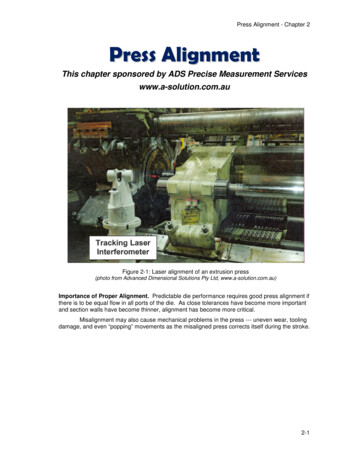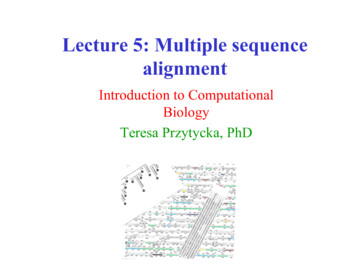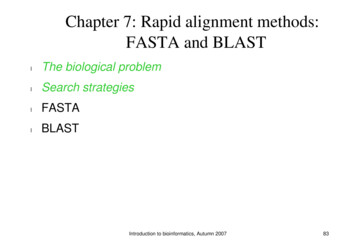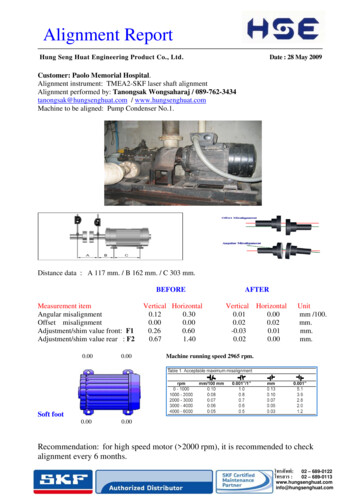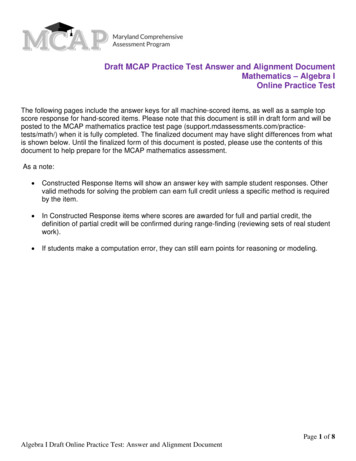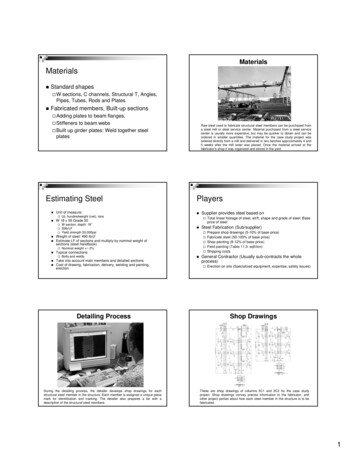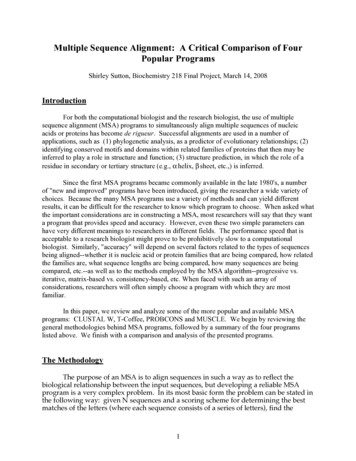
Transcription
Multiple Sequence Alignment: A Critical Comparison of FourPopular ProgramsShirley Sutton, Biochemistry 218 Final Project, March 14, 2008IntroductionFor both the computational biologist and the research biologist, the use of multiplesequence alignment (MSA) programs to simultaneously align multiple sequences of nucleicacids or proteins has become de rigueur. Successful alignments are used in a number ofapplications, such as (1) phylogenetic analysis, as a predictor of evolutionary relationships; (2)identifying conserved motifs and domains within related families of proteins that then may beinferred to play a role in structure and function; (3) structure prediction, in which the role of aresidue in secondary or tertiary structure (e.g., α helix, β sheet, etc.,) is inferred.Since the first MSA programs became commonly available in the late 1980's, a numberof "new and improved" programs have been introduced, giving the researcher a wide variety ofchoices. Because the many MSA programs use a variety of methods and can yield differentresults, it can be difficult for the researcher to know which program to choose. When asked whatthe important considerations are in constructing a MSA, most researchers will say that they wanta program that provides speed and accuracy. However, even these two simple parameters canhave very different meanings to researchers in different fields. The performance speed that isacceptable to a research biologist might prove to be prohibitively slow to a computationalbiologist. Similarly, "accuracy" will depend on several factors related to the types of sequencesbeing aligned--whether it is nucleic acid or protein families that are being compared, how relatedthe families are, what sequence lengths are being compared, how many sequences are beingcompared, etc.--as well as to the methods employed by the MSA algorithm--progressive vs.iterative, matrix-based vs. consistency-based, etc. When faced with such an array ofconsiderations, researchers will often simply choose a program with which they are mostfamiliar.In this paper, we review and analyze some of the more popular and available MSAprograms: CLUSTAL W, T-Coffee, PROBCONS and MUSCLE. We begin by reviewing thegeneral methodologies behind MSA programs, followed by a summary of the four programslisted above. We finish with a comparison and analysis of the presented programs.The MethodologyThe purpose of an MSA is to align sequences in such a way as to reflect thebiological relationship between the input sequences, but developing a reliable MSAprogram is a very complex problem. In its most basic form the problem can be stated inthe following way: given N sequences and a scoring scheme for determining the bestmatches of the letters (where each sequence consists of a series of letters), find the1
optimal pairing of letters between the sequences. Even this simplistic definitionrequires a consideration of the choice of sequence, choice of comparison model andoptimization of the model.The most common algorithms in use today are progressive alignments, based onthe work of Feng and Doolittle (1987). These algorithms are by nature heuristic andtherefore do not guarantee any level of optimization, but they do tend to be fast(Notredame, 2002). In brief, a set of N sequences are aligned by performing N-1pairwise alignments of pairs of proteins or pairs of intermediate alignments to create adistance matrix. The results of the distance matrix are used to create a (phylogenetic)guide tree. Sequences are added to the alignment one by one, with the most closelyrelated sequences aligned first, followed by the more distantly related ones, insertinggaps, if necessary (Edgar and Batzoglou, 2006; Notredame, 2007).The most influential component of progressive algorithms is the scoring schemesused by pairwise alignments (Notredame, 2007), in which the best alignment of twosequences is defined as the sum of substitution matrix scores for each pair of letters,minus gap penalties. Note that even a pairwise sequence alignment must be furthercategorized as being either a global alignment--one that spans the entire length of theinput sequence--or a local alignment--regions of aligned sub-sequences that may besurrounded by sequences that are completely unrelated.Pairwise alignment schemes can be divided into two types: matrix-based andconsistency-based. Matrix-based algorithms use a substitution matrix to determine thecost of matching two letters. The important point here is that the score for matchingtwo letters depends only on their position and their immediate surroundings.Consistency-based algorithms utilize a much larger volume of information: pairwiseglobal and local alignments are compiled; these compiled alignments are used as aposition-specific substitution matrix during a normal progressive alignment. As anexample of consistency-based scoring, consider three sequences A, B, and C. Thepairwise alignment of A-B and B-C may produce an alignment of A and C that isdifferent from a directly computed A-C alignment and may give us information as tothe "correct" alignment between A and C (Edgar and Batzoglou, 2006).Iterative alignments are a refinement of progressive alignments. Instead ofdepending heavily on the accuracy of the initial pairwise alignments, as the progressiveschemes do, iterative alignments optimize an objective function: they use an algorithmthat produces an alignment that is then refined through a series of cycles until no moreimprovements can be made (Notredame, 2002). There are a variety of ways to select thesequence subgroups and the objective function (see, for example, Hirosawa et. al., 1995).Depending on the strategy used to improve the alignment, the iterative method can beeither stochastic or deterministic. Deterministic strategies are the simpler of the two.Sequences are pulled one by one from an alignment and then re-aligned to theremaining sequences. When no more improvement can be made (i.e., convergence), theprocess is halted. Stochastic iterative methods use HMM training and simulatedannealing or genetic algorithms.The latest generation of MSA programs incorporates constraint-based methodsinto their progressive algorithms. The constraints generally come from three different2
sources: (1) the use of biologically relevant information encoded in databases such asPROSITE; (2) the use of local pairwise similarity present in multiple sequence pairs tohighlight similar regions in otherwise divergent sequences; (3) user-specified regions insequences they wish to see aligned in any multiple alignment computed (Papadopolouset. al., 2007).The ProgramsCLUSTAL WThe CLUSTAL set of MSA programs were first developed in 1988. As stated byHiggins and Sharp in their 1988 paper, CLUSTAL is essentially a "quick and dirty"version of the Feng and Doolittle (1987) pairwise progressive algorithm. What madethe CLUSTAL programs so attractive is that they could be run on so-calledmicrocomputers and therefore any researcher with a computer could perform sequencealignments right in the lab.Many of the algorithms developed after CLUSTAL are at least in part based onthe CLUSTAL model, so it is worth exploring this algorithm in some detail.There are three separate and distinct steps in the CLUSTAL MSA (Figure 1):o Calculation of all pairwise sequence similarities, which are then used to constructa distance matrix (also called a similarity matrix)o Construction of a dendogram (guide tree) from the distance matrix generated instep 1o Alignment of the sequences in a pairwise manner, following the order of theclustering as determined by the guide tree generated in step 2CLUSTAL W, an improvement on the original CLUSTAL program was introducedin 1994 (Thompson et. al., 1994), and its relative speed and sensitivity soon made it themethod of choice for biologists. The biggest problem with the original CLUSTALprograms is that their algorithms made certain assumptions that are not biologicallyrealistic. The enhanced sensitivity was due to three improvements incorporated intoCLUSTAL W: the use of a weighted sum-of-pairs, the use of varying gap penalties andthe use of neighbor-joining instead of UPGMA in the generation of the phylogenetictree.In older alignment algorithms, single-weight matrices were generated from thepairwise alignments. A single-weight matrix assumes that the sequences in a group tobe aligned are all equally divergent from each other. As long as this assumption is truethen the use of single weight matrices is justified. However, if the sequences in analignment group are too similar, then a single-weight matrix introduces a bias in favorof redundant sequences. If the sequences are divergent, then mismatches in sequencebecome more prevalent but single-weight matrices do not account for them. CLUSTALW assigns individual weights to sequences, in part by using neighbor joining toconstruct the phylogenetic tree: weights are assigned according to the tree branchlength, which is a measure of their evolutionary distance. This means that similar or3
redundant sequences will be downweighted while more divergent sequences areupweighted.CLUSTAL W also changed the way that gap penalties and gap opening weredetermined. To get an alignment between divergent sequences, alignment algorithmsuse gap penalties and gap extensions, but the older algorithms assigned fixed values toboth. This is not biologically realistic, as the gaps found in related proteins are notrandom occurrences. Regions of conserved structure or catalytic function (e.g., themotor domains of myosin or the P-loop nucleotide binding regions found in manyATPases) are much less likely to have gaps than the linkers that connect thesestructure/function domains. Before any pair of sequences or prealigned groups ofsequences are aligned, CLUSTAL W generates a table of gap opening penalties forevery position in the two (sets of) sequences. The initial gap-opening penalty is variedin both a residue and a position-specific manner, in order to make gaps more or lesslikely at different positions. The residue-specific gap penalties and locally reduced gappenalties in hydrophilic regions encourage new gaps in potential loop regions ratherthan regular secondary structure. Finally, positions in early alignments where gapshave been opened receive locally reduced gap penalties to encourage the opening up ofnew gaps at these positions.Although there have been no substantive changes to CLUSTAL W since it wasfirst released in 1994, a new member of the CLUSTAL family, CLUSTAL X, wasintroduced in 1997 (Thompson, et. al., 1997). This version uses the same algorithm asCLUSTAL W, but it has features that make it more user friendly (e.g., scrollablewindows, pull-menus, etc.) For a review of the CLUSTAL programs, see Chenna, et. al.(2003).T-CoffeeIn 2000 (Notredame et. al., 2000), the T-Coffee (Tree-based Consistency ObjectiveFunction for alignment Evaluation) alignment program was introduced. This was the firstalignment program to introduce any meaningful improvements on the CLUSTAL Walgorithm. Although T-Coffee is still a progressive alignment method, it is consistencybased and so takes advantage of a much larger body of information. It also has theability to consider information from all of the sequences during each alignment stepand not just those sequences being aligned at a certain stage.Programs such as CLUSTAL W are called "greedy heuristics." As we havepreviously described them, they start with pairwise alignments of sequences andgenerate a distance matrix. This matrix is used to generate a phylogenetic tree and thenthe tree is used to gradually build up the alignment by following the branches of thetree. This method has proved successful for a number of applications, but it doespossess a flaw that we have not yet discussed: if an error is made in the first set ofalignments, this error is then propagated through the rest of the alignments and cannotbe rectified later as the rest of the sequences are added in. Although T-Coffee is itself agreedy heuristic, it attempts to minimize the effect caused by errors in alignment thathappen early on, by making better use of the available information.4
T-Coffee has two main features. First, it uses heterogeneous data sources togenerate multiple alignments. The data from these sources are provided to T-Coffee viaa library of pairwise alignments. Thus, T-Coffee can compute MSAs using a library thatwas generated from a mixture of local and global pairwise alignments. Second, itcarries out progressive alignment in a way that allows it to consider the alignmentbetween all of the pairs during the generation of the MSA. This gives it the speed of atraditional progressive alignment but with far less tendency to misalign.The basic steps in a T-Coffee MSA are as follows (see Figure 2 for a schematic):o Generate a primary library of alignments Contains a set of pairwise alignments between all of the sequencesto be aligned Two alignment sources--one local, one global--for each pair ofsequences are used; yielding two libraries--one local, one globalo Derive the weights for the primary library A weight is assigned to each pair of aligned residues in the library The weights are assigned according to sequence identityo Combination of the libraries The libraries are pooled in a simple addition process Duplicated pairs are merged into a single entry Pairs that did not occur will not be represented (given a weight ofzero)o Extending the library Combine information so that the final weight, for any pair ofresidues, reflects some of the information contained in the wholelibrary Based on taking each aligned pair from the library and checking thealignment of the two residues with residues from the remainingsequences (consistency-based alignment)o Progressive alignment Score for the alignments xi to yj is the sum of the weights of thealignments in the library containing the alignment xi to yj. The distance matrix and neighbor-joining tree are determined' The initial pair is fixed at this point; any existing gaps cannot beshifted laterMUSCLEIn 2004 the MUSCLE (multiple sequence comparison by log-expectation)algorithm was introduced (Edgar, 2004). MUSCLE is a matrix-based algorithm, and likeother MSA algorithms, MUSCLE starts with a guide tree construction, where thefundamental step is pairwise alignment. The pairwise alignment is used first forprogressive alignment and then for refinement. There are two distinguishing feature ofMUSCLE. In determining distance measures for pairs of sequences, it uses both thekmer distance (for an unaligned pair) and the Kimura distance (for an aligned pair). Akmer is merely a contiguous sequence of letters of length k, also known as a word or ktuple. Sequences that are related will have more kmers in common than expected by5
chance. The kmer distance is derived from the fraction of kmers in common in acompressed alphabet, which is related to fractional identity. Because this measure doesnot require an alignment, MUSCLE has a significant speed advantage over other MSAalgorithms. The second distinguishing feature is that at the completion of any stage ofthe algorithm, a MSA is available and the algorithm can be terminated.Interestingly, distance matrices in MUSCLE are clustered using UPGMA, whichthe author says give marginally improved results over neighbor-joining, even thoughneighbor-joining gives a more reliable estimate of the taxonomic evolutionary tree. Heexplains this by saying that in progressive alignment, the best accuracy is obtained ateach node by aligning the two profiles that have fewest differences, even if thoseprofiles are not evolutionary neighbors.There are three main stages to the MUSCLE algorithm, as shown in Figure 3. Forstage 1, a progressive alignment of the sequences is generated. The kmer distance foreach pair of input sequences is calculated, and from this a matrix is constructed. Thematrix is used to construct the UPGMA tree. From the tree, the progressive alignmentis constructed by following the branching order of the tree. At each leaf, a profile isconstructed from an input sequence. Nodes in the tree are visited in prefix order(children before their parent). At each internal node, a pairwise alignment isconstructed of the two child profiles, giving a new profile that is assigned to that node.This produces an MSA.Stage 1 introduces error in the form of the approximate kmer distance, whichproduces a suboptimal tree. Stage 2, the improved progression stage, improves on thealignment generated in stage 1. MUSCLE starts by re-estimating the tree using theKimura distance, which is more accurate but requires an alignment. A progressivealignment is produced, yielding a second MSA. The trees from stages 1 and 2 arecompared; MUSCLE identifies a set of nodes for which the branching order is different.A new MSA is built if the order of the nodes has changed. Otherwise the first MA iskept.Stage 3 is the refinement stage. Here, an edge of the tree from stage 2 is deleted.This divides the tree into two sub-trees; the profile of the multiple alignment for eachsub-tree is calculated. The profiles from the two sub-trees are re-aligned, producing anew MSA. If the new sum-of-pairs score is improved, the new alignment is kept.Otherwise it is discarded. These steps are repeated until convergence or until a userdefined limit is achieved.ProbConsThe last algorithm we will present is ProbCons--probabilistic consistency-basedMSA (Do et. al., 2005). It is a progressive alignment consistency-based algorithm, butProbCons takes a very different approach to the formulation of the sequence alignmentproblem: it uses a three-state pair-hidden Markov model (HMM) as an alternativeformulation of the sequence alignment problem (Figure 4, Do et. al, 2005) whereemissions correspond to traditional substitution scores based on the BLOSUM62 matrixand transitions correspond to gap penalties which are trained with unsupervisedexpectation maximization.6
Other features that distinguish ProbCons from the algorithms we have presentedthus far include its use of maximum efficiency accuracy instead of Viterbi alignment,which is more commonly used on HMMs to generate sequence alignment. A Viterbialignment is similar to that of Needleman-Wunch, in that it selects a single alignmentwith the highest probability of being absolutely correct. In contrast, maximum expectedaccuracy selects the alignment with the largest number of correct predictions.ProbCons uses probabilistic consistency transformation to incorporate multiplesequence conversion information during pairwise alignment. This is a modification ofthe sum-of-scores method: the transformation is to re-estimate the posteriorprobabilities using three-sequence alignments instead of pairwise alignments.One final feature of note: ProbCons does not use any biological concepts such asevolutionary guide tree construction and position-specific gap scoring in its algorithm.The ProbCon algorithm has five main steps:o Computation of posterior-probabilities matrices For every pair of sequences x and y, a matrix is computed where theterms of the matrix are the probabilities that letter xi and yj are pairedin an alignment of x and y as generated by the modelo Computation of expected accuracies The expected accuracy of a pairwise alignment a between x and y to bethe expected number of correctly aligned pairs of letters, divided bythe length of the shorter sequenceo Probabilistic consistency transformation Re-estimate the matrix quality scores by applying the probabilisticconsistency transformationo Computation of a guide tree Use hierarchical clusteringo Compute progressive alignment Align sequence groups according to order specified in the guide treeA post-processing iterative step can be applied as necessary. Here, the alignment israndomly partitioned into two groups of sequences and re-aligned as required.DALIGN and COBALTIn the process of preparing this paper, we learned of two other algorithms thatdeserve at least an honorable mention. The distinguishing feature of DALIGN(Morgenstern, 1998) is that it aligns sequences both locally and globally using adiagonal method (hence the name DALIGN). Rather than compare single residues, itcompares whole interrupted stretches of residues that would form diagonals in a dotmatrix; it does not allow for mismatches or gaps. As a result, it has no gap penalty orgap extension, and may leave unrelated sequences unaligned.COBALT (constraint-based alignment tool) is one of the latest algorithms to bereleased (Papadopoulos and Agarwala, 2007). What makes COBALT unique is that itallows the user to enter constraints: the user can directly specify pairwise constraints7
and/or can ask COBALT to generate the constraints using sequence similarity,(optional) CDD (conserved domain database) searches and (optional) PROSITE patternsearches. COBALT will optionally create partial profiles for input sequences based onany CDD search result.AnalysisWhen assessing the performance of a MSA algorithm, the accepted way of doingthis is to do empirical tests using an established database of test sequences. To avoidpotential pitfalls that are inherent in this method of testing (some algorithms could beover-trained on a specific test by finding the parameter combinations that make apackage look best with a particular set of test cases; global aligners tend to over-alignsequences by aligning residues and regions of the sequences outside of the conservedcore that share no structural or homologous relationship; local aligners tend tomisalign), many software developers now test their programs on several of the manybenchmarking suites now available, such as BAliBASE, PREFAB and SABmark.Recently, a new simulation software package, Simprot, has been introduced (Nuin et.al., 2006). How these alignment databases are generated and what methods they use todetermine an accuracy score is a topic for another paper; we will assume that they havebeen tested and found to be useful tools. (For an analysis of the currently availablebenchmarks, see Blackshields et. al. 2006).Tables 1, 2 and 3 show the results of testing MSA algorithms with BAliBASE,PREFAB and SABmark, respectively. Note that the tests were run on several programsbesides just the four that were reviewed in this paper. From these results we see certaintrends. Consider first an overall score for accuracy. In all cases, a higher overall scoreindicates a better performance. Of the four programs reviewed here, ProbConsconsistently has the highest overall score, outperforming CLUSTAL W, T-Coffee andMUSCLE on all three benchmarks. This is particularly significant because ProbConswas trained on BAliBASE (Do et. al., 2005), so its performance on PREFAB andSABmark provide external validations of the BAliBASE results. CLUSTAL W, on theother hand, had the lowest overall score of the four programs that we reviewed(although not the lowest score of all of the programs tested; DALIGN scored even lowerthan CLUSTAL W on all three benchmarks). Note that CLUSTAL W scored better onBAliBASE than it did on the other two benchmarks. CLUSTAL W was trained onBAliBASE, so it is possible that the higher score with this benchmark reflects overtraining. T-Coffee and MUSCLE are intermediate in accuracy, falling betweenProbCons and CLUSTAL W.If we now consider running time, MUSCLE outperforms all of the programsreviewed here, in some cases by as much as 20 times (for example, compare the runtimes of MUSCLE and T-Coffee when the BAliBASE benchmark was used, Table 1).MUSCLE was optimized for speed (Edgar 2004), so its performance speed is expected tobe high. Contrast this with T-Coffee, the slowest of the four programs. It is interestingto note that the speed of T-Coffee is, in all cases, at least an order of magnitude slowerthan MUSCLE, the fastest program, although its accuracy as determined by its overallscore is comparable to both CLUSTAL W and MUSCLE.8
The four programs reviewed here have also been tested with Simprot, simulationsoftware that generates known alignments under realistic and controlled evolutionaryscenarios (Nuin et. a., 2006). For these tests, simulated sequences were used toinvestigate the effects of sequence length, indel frequency and length, evolutionarydistance, terminal gap length and tree topology. Figure 5 shows the overall results ofthese tests and compares them to the results from a BAliBASE test on the sameprograms. ProbCons generated the best alignments with Simprot, while CLUSTAL W(and DALIGN) had the worst accuracy. T-Coffee and MUSCLE fall somewhere in themiddle. These results follow the trend seen with BAliBASE, PREFAB and SABmark.For completeness sake, we also report on how COBLAT compares to the fourprograms reviewed in this paper. Figure 4 shows that COBALT outperforms ProbConson both the BAliBASE and PREFAB benchmarks but not on SABmark; COBLAT doesbetter than MUSCLE when both programs are tested with SABmark.Finally, we mention a report that tests the programs on their ability to detect andalign multiple sequences that possess insertions and deletions. These are commonfeatures in biologically relevant sequences, and their presence does affect the accuracyof MSA packages, but the extent to which alignment accuracy is affected by the positionof insertions and deletions is not often examined independently of other sources ofsequence variation (Golubchik et. al., 2007). In brief, data sets were constructed fromsequences chosen on the basis of their different lengths and organisms of origin, so as tocontrol for sequence-specific effects in the alignment. For each sequence so chosen, itwas replicated 10 times (Figure 6). A stretch of either 10 or 30 residues was deletedfrom each sequence. This shifted the gap origin either by one residue for overlappingdeletions or by the length of the deletion for no-overlapping deletions. MSA programswere then assessed for their ability to correctly place overlapping gaps withinsequences that contained overlapping deletions. The results are shown in Figure 7. Allfour programs reviewed here preferentially aligned gaps in a single vertical columnrather than the expected diagonally staggered band. Different programs opened thegap at different positions. DALIGN was the only exception, being able to recreate thecorrect staggered arrangement in over 60% of the tested alignments.ConclusionsSpeed, accuracy, memory: these are the three main criteria on which all MSAalgorithms are judged. Of the three, biological accuracy is arguably the most important.With the many MSA algorithms now available, and with their increasingly similar performancesand accuracy, it is difficult to objectively choose one method over another. Improvements toboth precision and speed are continuously being enacted. Nevertheless, analysis of some popularalgorithms show that, depending on what is important to the researcher, one method may bepreferred over another.CLUSTAL W, the oldest of the programs reviewed here, showed respectableperformance in both speed and accuracy, although there are certainly programs that are fasterand more accurate. The advantage of CLUSTAL W is that it strikes a balance between these9
measures. Disadvantages of CLUSTAL W are that it has no objective function and there is noreal way to quantify the resulting alignment.T-Coffee offers a distinct accuracy improvement over CLUSTAL W, by using acombination of local and global pairwise alignments to generate the sequence library, but itsincredibly slow speed may keep it from being widely implemented.MUSCLE, with its unique way of calculating distance measures (using kmer distance foran unaligned pair and Kimura distance for an aligned pair), progressive alignment using a newprofile function called the log expectation score, and refinement using tree-dependent restrictedpartitioning, has the clear and distinct advantage of speed. However, its accuracy is onlyintermediate as compared to ProbCons.ProbCons takes an innovative approach to the sequence alignment problem by using anHMM. It does not incorporate any biologically relevant information at all (no position-specificgap scoring, no rigorous evolutionary tree construction, etc.). Due to its use of maximumexpected accuracy as an objective function and the application of the probabilistic consistencytransformation, it has the highest overall accuracy of the four programs reviewed. Its speedhowever, could be improved upon.Finally, a word about COBALT. This program yielded speed and accuracy results that areabout intermediate as compared to the four programs reviewed here. Because it is a constraintbased program, however, it offers something that many researchers may find exciting--the abilityto input his/her own pairwise alignments.An admittedly unscientific survey indicates that even with all of the new algorithms,many researchers still prefer CLUSTAL W (personal communication with members of theStanford University Dept. of Biochemistry). This may be due, in part, to simple familiarity or anignorance of the wealth of other, arguably better, MSA packages. The prudent researcher woulddo well to avail himself/herself of the many MSA programs at his/her disposal.10
FiguresFigure 1. Flow chart of CLUSTAL MSA strategyas described in the text (Higgins and Sharp,1988).Figure 2. Layout of the T-Coffee strategy; the main stepsrequired to compute a MSA using the T-Coffee method.Square blocks designate procedures while rounded blocksindicate data structures (Notredame et. al., 2000).11
Figures, cont.Figure 3. This diagram summarizesthe flow of the MUSCLE algorithm.There are three main stages: Stage 1(draft progressive), Stage 2 (improvedprogressive) and Stage 3 (refinement).A multiple alignment is available atthe completion of each stage, at whichpoint the algorithm may terminate(Edgar, 2004).Figure 4. Basic pair-HMM for sequence alignmentbetween two
listed above. We finish with a comparison and analysis of the presented programs. The Methodology The purpose of an MSA is to align sequences in such a way as to reflect the biological relationship between the input sequences, but developing a reliable MSA program is a very complex problem. In its most basic form the problem can be stated in
